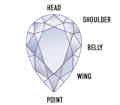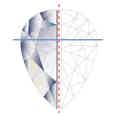PEAR SHAPE DIAMOND ANATOMY
About The Pear Shape
With its graceful, tapered outline, a pear shape diamond is an elegant and flattering choice for an engagement ring.
Here are the essentials for selecting the perfect pear shape.
Key Anatomy Of A Pear Diamond
Symmetry, Proportions & Setting
Reminiscent of a tear drop, a pear shape diamond blends the best of the round and marquise diamond shapes.
A pear shape diamond should have gently rounded shoulders. The shoulders should form attractive arches. If they’re too flat, they make the stone look too narrow. If they’re too round, they make it look short and stubby.
The pear shaped diamond, like the round brilliant diamond, is faceted to deliver the most sparkle and brilliance.
With the pear shape it is important to check the table is centred and well balanced. The example below illustrates a poorly shaped table.

Poorly Aligned Table
The culet should be pointed and equally distanced from each side of the diamond. Otherwise the symmetry of the stone will be poor and will distract from the appearance of the stone.
There is no official perfect "length to width" ratio of the pear shape diamond. This ratio is essentially a matter of personal choice.
Nevertheless, a length to width ratio between 1.5:1 and 1.75:1 is considered ideal within the diamond industry.
Length Greater Than Width
Expressed As A Length To Width Ratio
A pear diamond should always be set within at least three prongs to protect the two outermost curves and the point, which are typically the most vulnerable areas of the diamond.
As can be seen in the image below, the prong holding and protecting the diamond tip is slightly larger than a typical prong and shaped in harmony with the stone itself.
Larger carat weights may benefit from a five prong setting, such as this two carat solitaire by Tiffany & Co.
Alternatively, a more substantial V-shaped claw encasing the diamond tip should prove secure and robust, as illustrated by this three carat pear diamond ring from Cartier (image below).

Avoid The "Bow-Tie"
Many pear shape diamonds show a dark pattern that resembles a bow-tie. This pattern typically runs across the width of the stone from the center of the table.
The bow-tie on a well cut pear shape diamond should be minimal, but there will still be good contrast between light and dark areas in the stone.

Carat Weight
To ensure that the pear shape itself is clearly identifiable, it is best to opt for at least 0.50 carats.
Be mindful that the larger the carat weight the greater the importance of the symmetry and general proportions.
You may also opt for a diamond halo surround which will make the centre diamond appear larger or go for a lab created diamond to obtain a larger size stone at a similar price to a smaller natural mined diamond.
Fancy Coloured Pear Shape Diamonds
High grade larger carat weight coloured pear diamonds, especially in pink tones, are rare and commensurately expensive.
Alternatively, ethically created fancy coloured lab diamonds display exactly the same physical and aesthetic qualities and are significantly more affordable.








